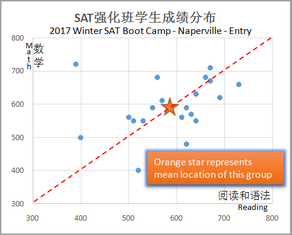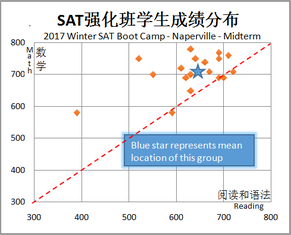|
Every new idea experiences criticism. The unified models featured in mind2learn SAT prep course as no exceptions. The doubts come in two folds. The first group brings an ideological one – how can one model solve all problems. While taking all reading passages through one CRM model is just hard to imagine, solving all math problems by mere EMM sounds totally insane. There is also a second group posing the practical question – show me the stats. Answers to both can come in one, the real results. Here are the stats. In the SAT boot camp I am teaching in Naperville IL, students were given an entry test that is a less-known SAT mock by a well-known publisher. Then the students were lectured 5 Sunday afternoon classes covering reading and math, and provided a grammar handout for self-study. A midterm of same quality as the entry were done after the completion of five lectures, which add up to 15 hours in reading and 6 hours in math. Here below are the stats of both tests. Stunning growths in the test scores among all students are marked in the graphs in comparison. On average, the sub-score of math increased by 110, while that of verbal by 45. Every student saw their growths on at least one subject if not both. Several students who entered the camp with mid 600s in reading saw their 700s. Surprisingly, one student who began with a 450 in math and a 520 in reading and found 690s in both subjects in the midterm. I am sure that the students have never seen the test before they were given. Isn’t it amazing? While criticism settles, I started to ponder. There is a problem, still, when I looked at the number. Why isn’t it same 100 growth in verbal as in math? My students and their parents can be happy with the current results, but I, as the teacher, am not satiated if I see rooms to improve.
Unlike math on which all students saw significant growth in this camp, reading and writing saw mixed results. While most of students increased by more than 50, a third of the class didn’t see significant improvement. Looking into the two sections in verbal, I found the answer. Slightly more than half did not see any growth in grammar, and some of them got even worse on it. The reason is simple – we haven’t spent time in grammar during lecture hours. I have been deeming grammar something my students can improve on their own. Spending any lecture hour on grammar is an abuse of the tuition. As a result, students were provided an 80-page grammar handout in beginning for self-study. Clearly, most of the students didn’t (want to) spend time self-study. To them, there is plenty of fun outside the books. In trying to be most helpful (in terms of score points), I summarized the most popular losses in grammar among the students and published them in three blog articles as Top Losses in SAT Grammar (1/3), (2/3) and (3/3). These information generally covers 10-15 questions in the grammar section where each question counts 9 points to the verbal sub-score. These students were added a lecture hour based on these write-ups. If you read these carefully, you are guaranteed to see at least 50 points back in your next report. Even 100 points, if you are really careful. Good luck!
0 Comments
Concise rules may be broken in case of... As we noted in the concision rules, there must be some exception. Students often blindly choose the shorter option and find their mistake later. Concision rules are not always true, especially when they are in conflict with consistence rules. Here are the most common examples that concision rules can be broken: 1) Consistence is needed when there is a parallel structure
2) Consistence to be kept when there is an apposition structure
3) Consistence to be kept with other part of the sentence
4) Consistence with general tone of the passage When the general tone is in certain verb tense, voice, mood, or other style choice of the author. (Sorry, no example provided here!) Concise rules: SAT loves keeping sentences shorter and structures simpler Shorter and simpler language options are generally (exceptions follow) preferred in SAT grammar. Redundancy within a sentence and across the same paragraph must be deleted. "To-do" is generally considered simpler than "for/in doing". Active voices are also determined better than passive voices. Here are some examples of concise rules. 1) Subordinating one term to another adds one more layer in structure, thus not optimal.
2) A phrase or clause in redundancy with another part of the sentence/paragraph
3) When it comes to forms of verbs, "to-do" is preferred over "doing"
4) Active voice is preferred over a passive one
Consistence in pre-position and parallel structures are very common loss in SAT writing and language section. 1) Consistence in pre-position structure: pre-position phrases lead by "like", "unlike", or "contrary to".
pre-position phrase lead by "verb-ing", "verd-ed", or "having verb-ed"
2) consistence in parallel structure: “and”, “or”, and “as well as”, and “from…to” connected terms
…not only…but also…
multiple terms separated by commas (each maybe long)
Sometimes several independent sentences can be parallel too
|
The F‘LOGsthink, teach and enjoy Archives
November 2023
Categories |



 RSS Feed
RSS Feed
